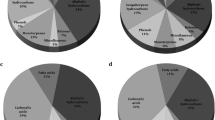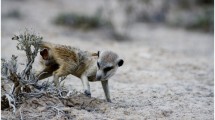Abstract
The volatile constituents in anal gland secretions of two sympatric Mustela species, the Siberian weasel (M. sibirica) and steppe polecat (M. eversmanni), were studied by the headspace technique, followed by gas chromatography–mass spectrometry (GC-MS) analysis. Nine sulfur-containing compounds were identified. They were 2,2-dimethylthietane, (Z)- or (E)-2,4-dimethylthietane, (E)-2,3-dimethylthietane, 2-ethylthietane, (E)-2-ethyl-3-methylthietane, (Z)-2-ethyl-3-methylthietane, 2-propylthietane, 3,3-dimethyl-1,2-dithiacyclopentane, and (Z)-3,4-dimethyl-2,2-dithiacyclopentane. Among them, (E)-2-ethyl-3- methylthietanes, (Z)-2-ethyl-3-methylthietanes, and (Z)-3,4-dimethyl-1,2-dithiacyclopentane were present in the polecat but not in the weasel. The predominant compound was 2,2-dimethylthietane in the weasel and (E)- or (Z)-2,4-dimethylthietane in the polecat. These differences were consistent between the two species, regardless of sex and age and, therefore, could possibly be used for species recognition. In the weasel, 2-ethylthietane was found only in the female, and the relative abundance of several compounds was significantly different between males and females. In the polecat, although no sex-specific volatile compounds were found, males and females differed in the relative abundance of several of the compounds. In both species, the relative abundance of some compounds varied with age. We conclude that these volatile compounds can be used to communicate information about species, sex, and age.
Similar content being viewed by others
REFERENCES
Brinck, C., Gerell, R., and Odham, G. 1978. Anal pouch secretion in mink, Mustela vison. Oikos 38:68–75.
Brinck, C., Erlinge, S., and Sandell, M. 1983. Anal sac secretion in mustelids: A comparison. J. Chem. Ecol. 9:727–745.
Brown, R. E. 1979. Mammalian social odors: A critical review. Adv. Study Behav. 10:103–162.
Brown, R. E., and Macdonald, D. W. 1985. Social Odours in Mammals. Oxford University Press, Oxford.
Crump, D. R. 1980a. Thietanes and dithiolanes from the anal gland of the stoat (Mustela erminea). J. Chem. Ecol. 6:341–347.
Crump, D. R. 1980b. Anal gland secretion of the ferret (Mustela putorius furo). J. Chem. Ecol. 6:837–844.
Crump, D. R. and Moors, P. J. 1985. Anal gland secretions of the stoat (Mustela erminea) and the ferret (Mustala putorius furo): Some additional thietane components. J. Chem. Ecol. 8:1037–1043.
Ebling, F. J. 1977. Hormonal control of mammalian skin glands, pp. 17–34, in D. Müller-Schwarze, and M. M. Mozell (eds.). Chemical Signals in Vertebrates, Plenum Press, New York.
Erlinge, S., Sandwell, M., and Brinck, C. 1982. Scent marking and its territorial significance in stoat, Mustela erminea. Anim. Behav. 30:811–818.
Gao, Y. 1987. Fauna Sinica: Mammalia. Vol. 8. Carnivora. Science Press, Beijing (in Chinese).
Gorman, M. L., Jenkins, D., and Harper, R. J. 1978. The anal scent sacs of the otter (Lutra lutra). J. Zool. 186:463–474.
Jorgenson, J. W., Novotny, M., Carmack, M., Copland, G. B., Wilson, S. R., Whitten, W. K., and Katona, S. 1978. Chemical scent constituents in the urine of the red fox (Vulpes vules L.) during the winter season. Science. 199:796–798.
MŰller-Schwarze, D. 1974. Olfactory recognition of species, groups, individuals and physiological states among mammals, pp. 316–326, in M. C. Birch (ed.). Pheromones. North Holland Publishing, Amsterdam.
Raymer, J., Wiesler, D., Novotny, M., Asa, C., Seal, U. S., and Mech, L. D. 1985. Chemical investigations of wolf (Canis lupus) anal-sac secretion in relation to breeding season. J. Chem. Ecol. 5:593–608.
Sheng, H. and Lu., H. 1976. Identification of adult-juvenile weasels (Mustela sibirica) and its productive significance during the hunting season. Acta Zool. Sin. 22(4):329–335 (in Chinese).
Sokolov, V. E., Albone, E. S., Flood, P. F., Heap, P. E., Kagan, M. Z., Vasilieva, V. S., Roznov, V. V., and Zinkevich, E. P. 1980. Secretion and secretory tissues of the anal sac of the mink, Mustela vison: Chemical and histological studies. J. Chem. Ecol. 6:805–825.
Sun, L. 1996. Chemical kin recognition in the beaver (Castor canadensis): Behavior, relatedness and information coding. PhD thesis. State University of New York, College of Environmental Science and Forestry, Ithaca, New York.
Sun, L. and MŰller-Schwarze, D. 1998. Anal gland secretion codes for relatedness in the beaver,Castor canadensis. Ethology 104:917–927.
Sun, L. and MŰller-Schwarze, D. 1999. Chemical signals in the beaver: One species, two secretions, many functions? pp. 281–288, in R. E. Johnston, P. Sorensen, and D. MŰller-Schwarze (eds.). Advances in Chemical Signals in Vertebrates. Kluwer Academic/Plenum Publishers, New York.
Author information
Authors and Affiliations
Corresponding author
Rights and permissions
About this article
Cite this article
Zhang, JX., Sun, L., Zhang, ZB. et al. Volatile Compounds in Anal Gland of Siberian Weasels (Mustela sibirica) and Steppe Polecats (M. eversmanni). J Chem Ecol 28, 1287–1297 (2002). https://doi.org/10.1023/A:1016246120479
Issue Date:
DOI: https://doi.org/10.1023/A:1016246120479




